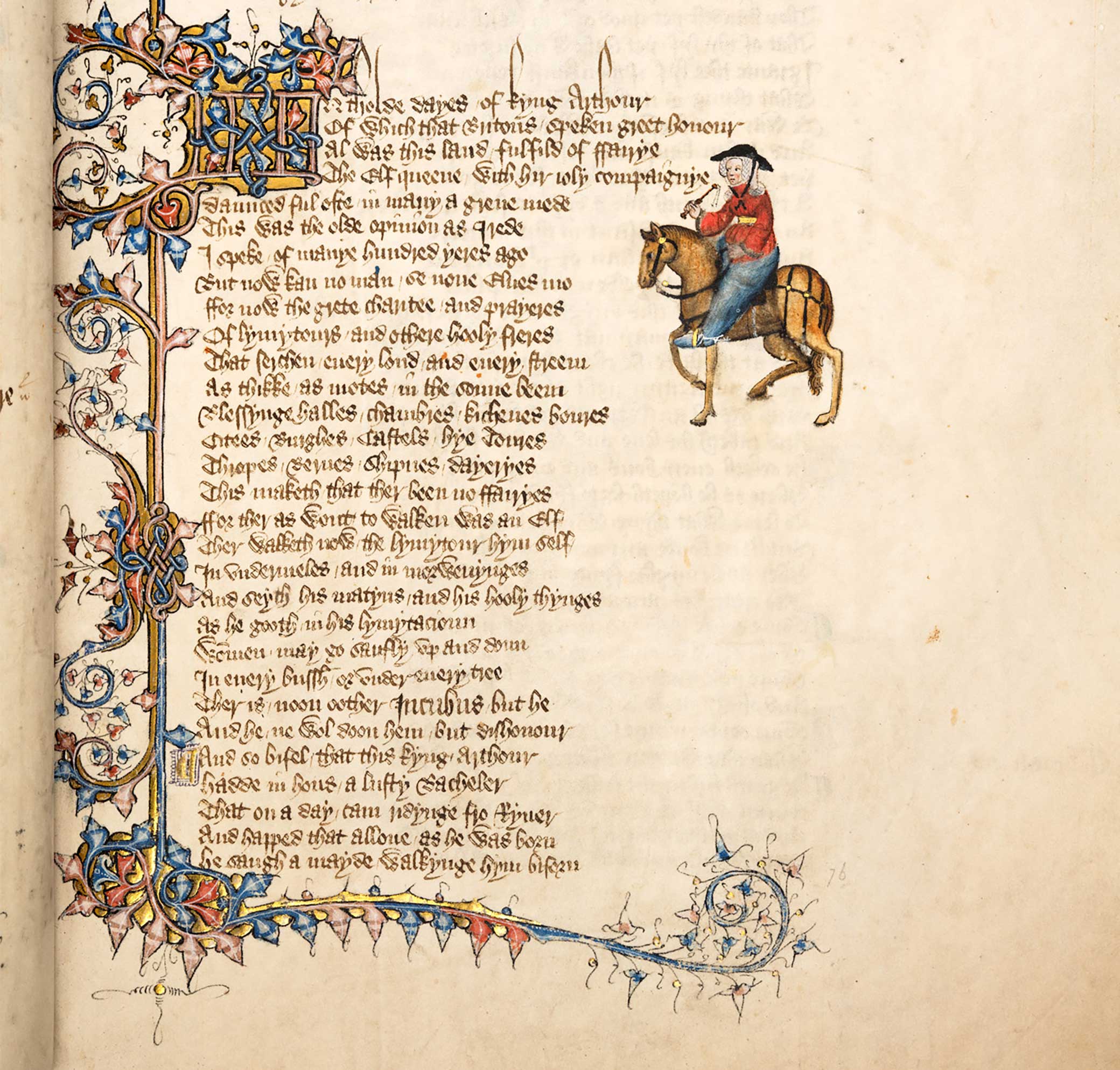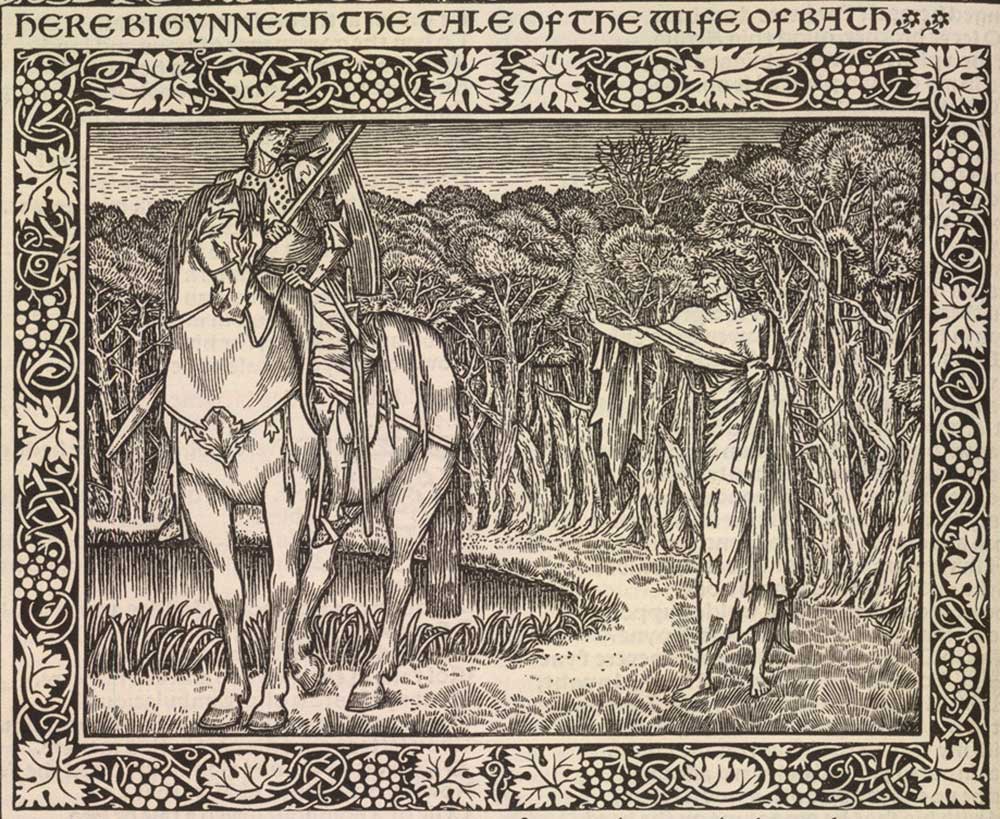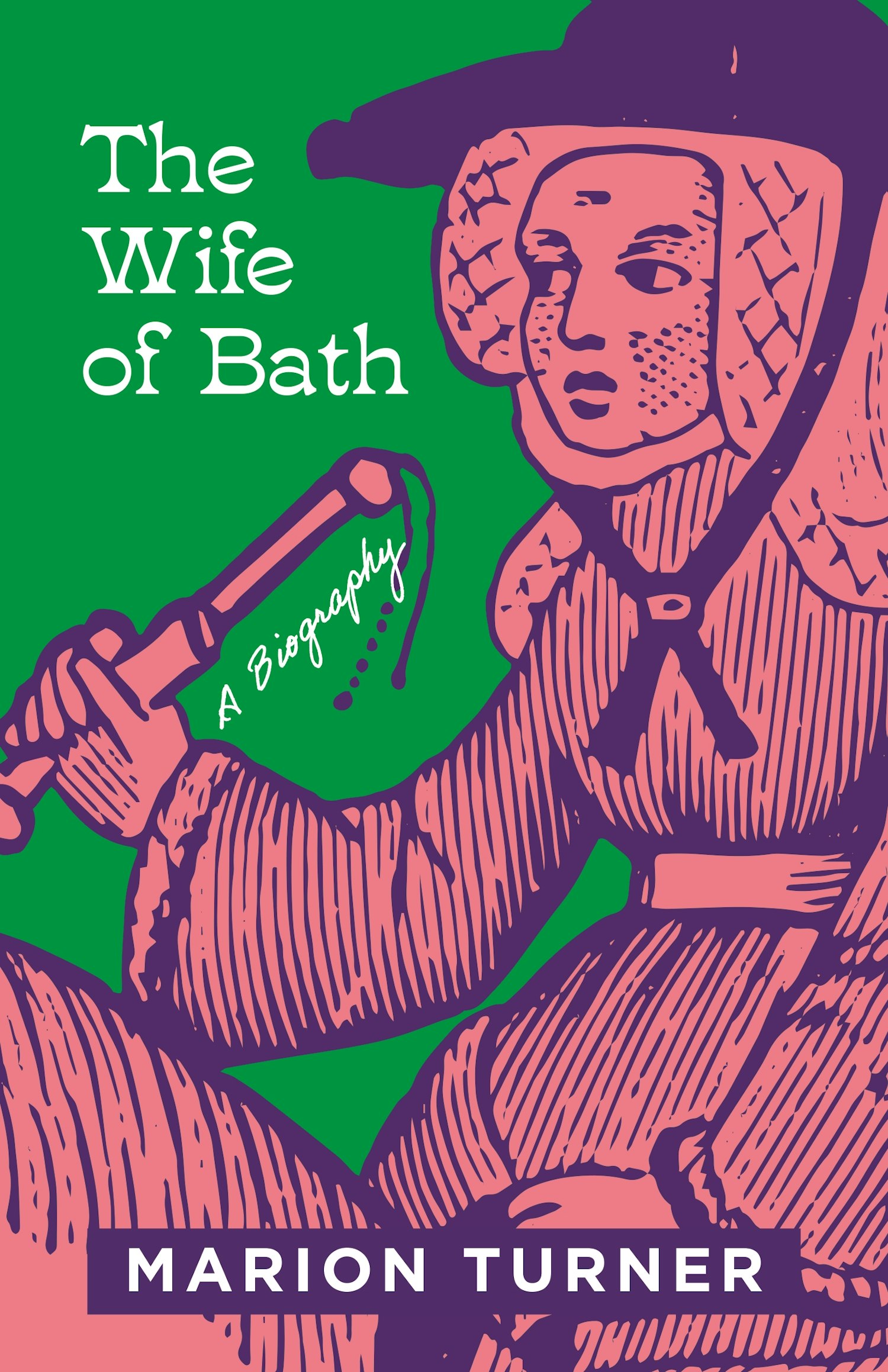
Opening page of “The Prologue of the Wife of Bath’s Tale,” from the Ellesmere manuscript of Geoffrey Chaucer’s Canterbury Tales, c. 1400. Wikimedia Commons.
It might have been my mother or it might have been the Wife of Bath.
—Hilary Mantel, The Mirror and the Light
Hilary Mantel’s reference to the Wife of Bath, in her wildly popular 2020 novel set in the time of Henry VIII, makes two assumptions: first, that modern readers know who the Wife of Bath is; and second, that they understand what she might have signified in Thomas Cromwell’s world. In this scene, Cromwell (Henry VIII’s right-hand man) is telling his closest colleagues about how Geoffrey de la Pole will respond to interrogation, saying that he will endlessly obfuscate and will keep contradicting himself, saying something happened in October or March; in Sussex (far south) or Yorkshire (in the north); that the person involved might have been his mother or might have been the Wife of Bath. The implication is that Geoffrey Chaucer’s heroine is as well-known as the months or English geography or one’s parents.
And, although she is presented here as a foil to Geoffrey’s mother, in fact the two women are rather similar. Margaret de la Pole, suspected of treason to the king (and later executed for it), was a woman who, like Alison of Bath, challenged authority and went her own way, as many medieval women did. Mantel correctly implies here that in the sixteenth century and in the twenty-first, Alison of Bath was and is part of the cultural fabric of many English-speaking women’s and men’s lives. Why has this character from a fourteenth-century poem had such a dramatic impact across time?
The Wife of Bath is the first ordinary woman in English literature. By that I mean the first mercantile, working, sexually active woman—not a virginal princess or queen, not a nun, witch, or sorceress, not a damsel in distress nor a functional servant character, not an allegory. A much married woman and widow, who works in the cloth trade and tells us about her friends, her tricks, her experience of domestic abuse, her long career combating misogyny, her reflections on the aging process, and her enjoyment of sex, Alison exudes vitality, wit, and rebellious self-confidence.
Alison is a character whom readers across the centuries have usually seen as accessible, familiar, and, in a strange way, real. For many people she is by far the most memorable of the Canterbury pilgrims. Almost from the moment of her conception, she exceeded her own text, appearing in Chaucer’s other writings (in a way no other character does) before being seized and appropriated by readers, scribes, and other poets alike. Over and over again, in different time periods and cultural contexts, readers see her as “relatable” in certain ways, as a three-dimensional figure who is far more than the sum of her parts. She may be “ordinary,” but she is also extraordinary. Chaucer performed some kind of alchemy when he fused his cluster of well-worn sources with contemporary details and a distinctive, personalized voice and produced something—someone—completely new.
Before Chaucer, there had never been characters like this at all in English literature: characters from ordinary life who talk about themselves and their own experiences in detail, narrating personal histories and encouraging sympathetic response and identification. The emergence of this self-conscious, narrating “I” figure was largely a new phenomenon in the late fourteenth century. The fact that Chaucer developed this kind of literary narrator in the form of a confident, well-off mercantile woman who tells jokes, enjoys sex, and thinks for herself about the male canon and the exclusion of women’s voices from it is astounding.
Where does she come from, and what happens to her after her triumphant emergence in her prologue and tale? Undoubtedly Chaucer’s favorite character, she has generally been his readers’ favorite, too (with some notable exceptions—such as the poet William Blake, who called her “a scourge and a blight,” and the critic D.W. Robertson, who thought her “hopelessly carnal and literal”).
The Wife of Bath was created at a moment in English history that saw extraordinary demographic change. Like the First World War, the plague was a demographic catastrophe that had the consequence of giving women greater opportunities in a time of labor shortage. The Black Death was an unprecedented and unparalleled event. Probably around a third of the population of Europe died in the first wave (1348–49), and it returned periodically for the rest of the century.
In the wake of the plague, there was more social mobility. Anxiety about wage rises was manifested in Statutes of Laborers, and sumptuary laws were passed to try to control the clothing that people wore. These attempts to prevent social climbing and class mobility failed, and the second half of the fourteenth century saw an increased loosening of feudal bonds and ideology, already on the wane. Historians have discussed the fourteenth and fifteenth centuries as a “golden age for women,” especially in London.
While there are differing opinions, particularly about just how golden the age was and how long it lasted, most do agree that there was an increase in women’s opportunities and status in England in the fourteenth and fifteenth centuries. They had some economic power, as seen, for instance, in the formalization of their right—whether single, married, or widowed—to trade as femes sole, rather than under the governance of their husbands. This meant a woman could run her own business, be responsible for her own money and taxes, and train her own apprentices. Jointures developed, allowing a woman to own property jointly with her husband, so that she could bequeath it as she wished. In some cases we even see women disposing of jointly owned property against their husbands’ desires.
Chaucer witnessed the growing opportunities for women—and he himself had a mother who owned property and a wife who always earned her own money (she worked as a lady-in-waiting in great households). In the second half of the fourteenth century, there was a plethora of London-based poets from the middling orders writing in English, married, working in the city at paid jobs—rather than in monastic or courtly environments. John Gower, William Langland, and Thomas Hoccleve all fit this general model as well as Chaucer. Culturally, Chaucer was also strongly influenced by Italian humanism and its focus on ethics. As Chaucer’s writing career progressed, and as he aged, he increasingly turned away from poetry that focused (sympathetically) on women as courtly marriage objects and toward poetry that portrayed women as intelligent, active, ethical forces in the world (women such as the “loathly lady” in the Wife of Bath’s Tale).
The Wife of Bath shows us how literary forms and lived experience affect each other. Alison is neither a real medieval woman nor a figure made entirely out of textual stereotypes. Thinking about her involves considering the knotty relationship between representation and reality, the way that perception and ideological ideas about women impact upon the treatment of women in society—and vice versa. As Georges Duby, one of the great historians of the Middle Ages, wrote, “Human beings do not orient their behavior toward real events and circumstances, but rather to their image of them.”
To understand how experience and authority clash in her very creation as a character, we might explore how Alison herself graphically suggests there can be a link between written ideas about women and the physical, bodily experience of domestic violence. The “book of wikked wyves” does not appear until line 635 of her prologue, when she is telling us about her violent, misogynist, young fifth husband. Alison recounts briefly how Jankyn hit her because she tore a leaf out of his book, and that the blow deafened her. She then fleshes out the details: that she kept some independence after her marriage, but her husband would preach to her about Roman marriages, Bible stories, and proverbs. The book then becomes the focus as Alison recounts its oppressive contents: anti-women, anti-marriage tracts by, for instance, Jerome, Tertullian, and Theophrastus. Jankyn gets great pleasure from luxuriating in misogyny; he reads it “gladly,” “for desport,” and laughs always when he reads it, which he does whenever he has “leyser” (i.e., leisure). Alison digresses for her famous speech about institutional misogyny and the bias of the canon, asking, “Who painted the lion?” in order to point out that art is biased—humans tell a story different from that which the lion would tell, just as men’s versions of life are different from women’s.
And women, like lions, have not had the chance to write stories. If they had, she says that they would have told of all the wickedness of men. When clerks are old and impotent, she claims, they sit down and write terrible things about women. Alison now returns to her story, how Jankyn every night would sit and read out insulting, aggressive stories about women.
Eventually, when she sees he will never stop, she rips out three pages and hits her husband so that he falls backward into the fire. He jumps up and hits her so hard on the head that she lies as if unconscious—and has genuinely been deafened. Although the book only appears late in the prologue, and late in Alison’s life, it is clear from the start that she is herself partly constructed out of the stereotypes in that kind of book, which tended to focus on many of the qualities that Alison delightedly demonstrates. (She gossips! She drinks! She tells her husband’s secrets! She looks for a new husband at her previous husband’s funeral!) To a certain extent, she came out of that book avant la lettre. It is also clear, as already noted, that she is constructing her own arguments in relation to the arguments of men such as Jerome. The book of wicked wives—not Jankyn’s specific book, but the weight of antifeminist literature—oppresses both female characters and real women. As Alison points out, because the pen has been so firmly in men’s and not women’s hands, there are no reasonable role models for women in literature or in life. She herself, as a literary character, is made out of male stereotypes.

Medieval antifeminists would say that she demonstrates just how right they are about women; some modern feminists would concur that Chaucer stages her voice in such a way as to demonstrate women’s traditional inadequacies. But she steps outside these stereotypes in a metatextual moment when she declares her own awareness of the limitations of the canon—a moment at which she moves away from the texts of Jerome or Jean de Meun and instead uses a fable (who painted the lion?). The image of Jankyn and Alison sitting by the fire, reading a compendium manuscript of texts “bounden in o volume,” injects another note of late medieval “realism” into the scene. In other words, it encourages us to think about what it might be like for an actual woman to sit there listening to terrible stories about women, hour after hour. After describing Jankyn’s misogynist speech for seventy lines, Alison starkly states: “Who wolde wene, or who wolde suppose / The wo that in myn herte was, and pyne?” This is how it feels to be the recipient of unrelenting misogyny—unimaginable, unspeakable. It is also a moment in which this textual figure describes her memory and her emotions and invites the readers to enter into her world, to try to imagine what it is like to be her. Far more than an embodiment of antifeminist stereotypes, Alison and her text here encourage us to critique those source materials and to think about individual experience rather than official authority.
Crucially, and disturbingly, the book becomes the occasion for violence. Alison starkly tells us, “I was beten for a book.” Life and texts, history and literature come together here. If we pretend that texts are wholly separable from life (authority from experience), that literary stereotypes have no connection to lived reality, we risk ignoring the violence that is enacted on bodies precisely because of what people have read in books. The way that women are treated in life is everywhere inflected by, as Virginia Woolf writes, the specter of Professor von X “writing his monumental work entitled The Mental, Moral and Physical Inferiority of the Female Sex.” The Wife of Bath is many things, but one of those things is a representation of the dissonance between the reality of medieval women’s experience on the one hand and the textual misogyny that attacked women for perfectly normal behavior (such as remarriage) on the other. These books of wicked wives were real medieval books: compilations of misogynist tracts, to which Chaucer must have had access. When she describes the book, Alison first mentions three principal texts, those by Valerius Maximus, Theophrastus, and Jerome. Thirty-five extant manuscripts have been identified that contain Jerome’s Adversus Jovinianum plus either Valerius or Theophrastus, with eleven that contain all three. Real medieval widows, whose behavior was entirely normal and in fact encouraged, still had to contend with books that insulted them in every possible way.
Excerpted from The Wife of Bath: A Biography by Marion Turner. Copyright © 2023 by Princeton University Press. Reprinted by permission.
